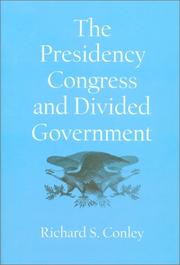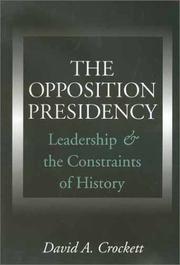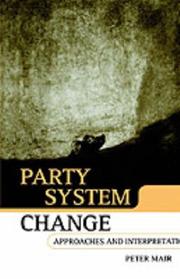| Listing 1 - 10 of 224 | << page >> |
Sort by
|

ISBN: 1299053580 1603446818 1585449814 9781585449811 1585442119 9781585442119 9781299053588 9781603446815 Year: 2003 Publisher: College Station Texas A & M University Press
Abstract | Keywords | Export | Availability | Bookmark
 Loading...
Loading...Choose an application
- Reference Manager
- EndNote
- RefWorks (Direct export to RefWorks)
Can presidents hope to be effective in policy making when Congress is ruled by the other party? Conley argues that the conditions of "divided government" have changed in recent years, and he applies a rigorous methodology to examine the success of presidential initiatives, the strategies presidents use in working with the legislature, and the use of veto power. "Although split-party control has not produced policy deadlock or gridlock, neither has its impact on presidential leadership and the retention of congressional prerogatives been adequately explored and analyzed."-Lou Fisher.
Divided government --- Political parties --- Political science --- Opposition (Political science) --- United States --- Politics and government --- 1945-1989 --- 1989 --- -Divided government

ISBN: 9781585449822 1585449822 9781585449828 1585441570 9781585441570 Year: 2002 Volume: no. 11 Publisher: College Station Texas A & M University Press
Abstract | Keywords | Export | Availability | Bookmark
 Loading...
Loading...Choose an application
- Reference Manager
- EndNote
- RefWorks (Direct export to RefWorks)
Presidents --- Political culture --- Political leadership --- Opposition (Political science) --- Political opposition --- Political science --- Divided government --- History.
Book
ISBN: 0300235127 9780300235128 9780300207132 0300207131 9780300245738 Year: 2018 Publisher: New Haven
Abstract | Keywords | Export | Availability | Bookmark
 Loading...
Loading...Choose an application
- Reference Manager
- EndNote
- RefWorks (Direct export to RefWorks)
Alan I. Abramowitz has emerged as a leading spokesman for the view that our current political divide is not confined to a small group of elites and activists but a key feature of the American social and cultural landscape. The polarization of the political and media elites, he argues, arose and persists because it accurately reflects the state of American society. Here, he goes further: the polarization is unique in modern U.S. history. Today's party divide reflects an unprecedented alignment of many different divides: racial and ethnic, religious, ideological, and geographic. Abramowitz shows how the partisan alignment arose out of the breakup of the old New Deal coalition; introduces the most important difference between our current era and past eras, the rise of "negative partisanship"; explains how this phenomenon paved the way for the Trump presidency; and examines why our polarization could even grow deeper. This statistically based analysis shows that racial anxiety is by far a better predictor of support for Donald Trump than any other factor, including economic discontent.
Political culture --- Polarization (Social Sciences) --- Identity politics --- Political parties --- Divided government --- Trump, Donald, --- United States --- Politics and government --- Social conditiond

ISBN: 3486567039 3486594540 1306778743 Year: 2003 Publisher: De Gruyter
Abstract | Keywords | Export | Availability | Bookmark
 Loading...
Loading...Choose an application
- Reference Manager
- EndNote
- RefWorks (Direct export to RefWorks)
Die Demokratische Bauernpartei Deutschlands war ein Ziehkind der sowjetischen Besatzer. 1948 geschaffen, um die SED zu stützen, sah diese in der neuen Blockpartei nicht selten eine Rivalin, der sie mit Geringschätzung begegnete. Die DBD sollte nicht nur die Folgen der Bodenreform auf dem Land auffangen, sie war auch maßgeblich daran beteiligt, die Agrarrevolution von oben durchzusetzen, deren Umsetzung ebenso wie die Entscheidung über die Kollektivierungsschübe von 1952 und 1960/63 hier neu rekonsturiert werden. Angeleitet und kontrolliert wurde die DBD von drei Stellen: zuerst von den fast allmächtigen Besatzern, dann zunehmend von der SED und ihrem Apparat. Dass letztere den Staatssicherheitsdienst zu einer umfassenden Durchdringung der Parteispitze, ab 1959 regelrecht zur Steuerung der Blockpartei nutzte, kann hier erstmals detailliert aufgezeigt werden. Der DBD gelang es anfangs, die traditionell antikommunistische bäuerliche Bevölkerung anzusprechen und die verschiedenen sozialen Gruppen in den Dörfern zu integrieren. Die Kollektivierung jedoch spaltete die Basis und stieß viele Funktionäre ab. Gerade diese Auseinandersetzung, Hand in Hand mit der Eliminierung nonkonformen Personals, formte die DBD zu einer Kaderpartei. Als das Parteiprogramm keinen Unterschied mehr zu dem der SED aufwies, verfiel die Basis 1960 in Apathie.
Political parties --- Agriculture --- Demokratische Bauernpartei Deutschlands --- History. --- Parties, Political --- Party systems, Political --- Political party systems --- Political science --- Divided government --- Intra-party disagreements (Political parties) --- Political conventions
Book
ISBN: 9681208870 6076288000 Year: 2005 Publisher: México, D.F. Colegio de México
Abstract | Keywords | Export | Availability | Bookmark
 Loading...
Loading...Choose an application
- Reference Manager
- EndNote
- RefWorks (Direct export to RefWorks)
Este libro gira en torno a varias hipótesis. La primera es que Vicente Fox no es el iniciador del cambio, sino resultado de éste. Fox es el iniciador de la alternancia política. Sin embargo, él es el resultado de las transformaciones profundas que se dieron en el país durante los gobiernos de Carlos Salinas y Ernesto Zedillo: abandono de la filosofía revolucionaria y acogida a la privatización, la globalización, la democracia representativa y las reformas a la Constitución en materia religiosa. La segunda hipótesis es que la alternancia política fue un parto asistido por un presidente que llegó al poder con el apoyo del PRI. Otra hipótesis es que la plena transición a la democracia será incompleta hasta que ésta no se haga compatible con la gobernabilidad. Asimismo se abordan asuntos que constituyen algunos desafíos al futuro de la nueva democracia mexicana, como la seguridad pública, la protección al medio ambiente y los derechos humanos.
Internal politics --- Mexico --- Democracy --- Political parties --- Opposition (Political science) --- Politics and government --- Political opposition --- Political science --- Divided government --- History of the Americas
Book
ISBN: 0691046050 9781400868445 1400868440 9780691620305 9780691046051 069162030X 9780691046051 Year: 2015 Publisher: Princeton, NJ
Abstract | Keywords | Export | Availability | Bookmark
 Loading...
Loading...Choose an application
- Reference Manager
- EndNote
- RefWorks (Direct export to RefWorks)
The first mass political parties appeared in the United States in the 1830's, as the majority of adult white males identified ardently with the Democratic and Whig parties. Ronald Formisano opens a window on American political culture in this case study of antebellum voting and party formation in Michigan. Examining the social bases of voter commitment and the dynamics of grass roots loyalties from Jackson to Lincoln, he proposes that the forming of parties had little to do with issues of political economy, but rather with value conflicts generated by the evangelicals' promotion of a moral society.Borrowing from other disciplines, and elaborating some of the analytical techniques used by Lee Benson in The Concept of Jacksonian Democracy, Professor Formisano studies demographic and voting data to determine patterns of partisan loyalty. His study throws light on the roots of the modern Republican Party, links between religion and politics, and the role of ethnic and cultural loyalties in political life.Originally published in 1971.The Princeton Legacy Library uses the latest print-on-demand technology to again make available previously out-of-print books from the distinguished backlist of Princeton University Press. These editions preserve the original texts of these important books while presenting them in durable paperback and hardcover editions. The goal of the Princeton Legacy Library is to vastly increase access to the rich scholarly heritage found in the thousands of books published by Princeton University Press since its founding in 1905.
Political parties --- History. --- Michigan --- History --- Parties, Political --- Party systems, Political --- Political party systems --- Political science --- Divided government --- Intra-party disagreements (Political parties) --- Political conventions
Book
ISBN: 0191612316 1283713470 9780191612312 9781283713474 9780191744907 0191744905 9780199652785 0199652783 Year: 2012 Publisher: Oxford Oxford University Press
Abstract | Keywords | Export | Availability | Bookmark
 Loading...
Loading...Choose an application
- Reference Manager
- EndNote
- RefWorks (Direct export to RefWorks)
'The Strain of Representation' examines the quality of democratic representation in Europe, focusing on the way that political parties channel the preferences of different groups of citizens into government policies.
Book
ISBN: 9780521717687 9780511790652 9780521888936 9780511438134 0511438133 0511437463 9780511437465 0511790651 052188893X 052171768X 1107386624 1107187486 128190340X 9786611903404 0511436009 0511435215 0511436785 9781107386624 9781107187481 6611903402 9780511436000 9780511435218 9780511436789 9781281903402 Year: 2008 Publisher: Cambridge New York Cambridge University Press
Abstract | Keywords | Export | Availability | Bookmark
 Loading...
Loading...Choose an application
- Reference Manager
- EndNote
- RefWorks (Direct export to RefWorks)
The political parties in Congress are as polarized as they have been in 100 years. This book examines more than 30 years of congressional history to understand how it is that the Democrats and Republicans on Capitol Hill have become so divided. It finds that two steps were critical for this development. First, the respective parties' constituencies became more politically and ideologically aligned. Second, members ceded more power to their party leaders, who implemented procedures more frequently and with greater consequence. In fact, almost the entire rise in party polarization can be accounted for in the increasing frequency of and polarization on procedures used during the legislative process.
United States. Congress --- Political parties --- United States --- Opposition (Political science) --- Political opposition --- Political science --- Divided government --- United States. --- Social Sciences --- Political Science

ISBN: 1135835616 1282324993 9786612324994 020312958X 9780203129586 041637400X 9780416374001 9781135835569 113583556X 9781135835606 1135835608 9781135835613 9781138408159 9781282324992 6612324996 Year: 1985 Publisher: London New York Methuen
Abstract | Keywords | Export | Availability | Bookmark
 Loading...
Loading...Choose an application
- Reference Manager
- EndNote
- RefWorks (Direct export to RefWorks)
The theme of Professor Evans' book is the growth of a recognizable modern party system from the much looser and often family-based attachments from the eighteenth century. Many periods and topics are dealt with in this comprehensive book.
Political parties --- Parties, Political --- Party systems, Political --- Political party systems --- Political science --- Divided government --- Intra-party disagreements (Political parties) --- Political conventions --- History --- Great Britain --- Politics and government

ISBN: 128198132X 9786611981327 0191521949 9780191521942 9780198292357 019829235X 9780191599804 0191599808 019829235X 0198295499 9780198295495 6611981322 Year: 1997 Publisher: Oxford : New York : Clarendon Press ; Oxford University Press,
Abstract | Keywords | Export | Availability | Bookmark
 Loading...
Loading...Choose an application
- Reference Manager
- EndNote
- RefWorks (Direct export to RefWorks)
This is the first full-length book to examine how we interpret evidence of change and stability in modern parties and party systems. Amidst the widespread contemporary discussions of the challenge to modern democracy and the crisis of traditional forms of political representation, it offers a welcome emphasis on how party systems survive, and on how change, when it does occur, may be analysed and understood.
Political parties --- Parties, Political --- Party systems, Political --- Political party systems --- Political science --- Divided government --- Intra-party disagreements (Political parties) --- Political conventions --- History --- Europe --- Politics and government
| Listing 1 - 10 of 224 | << page >> |
Sort by
|

 Search
Search Feedback
Feedback About UniCat
About UniCat  Help
Help News
News